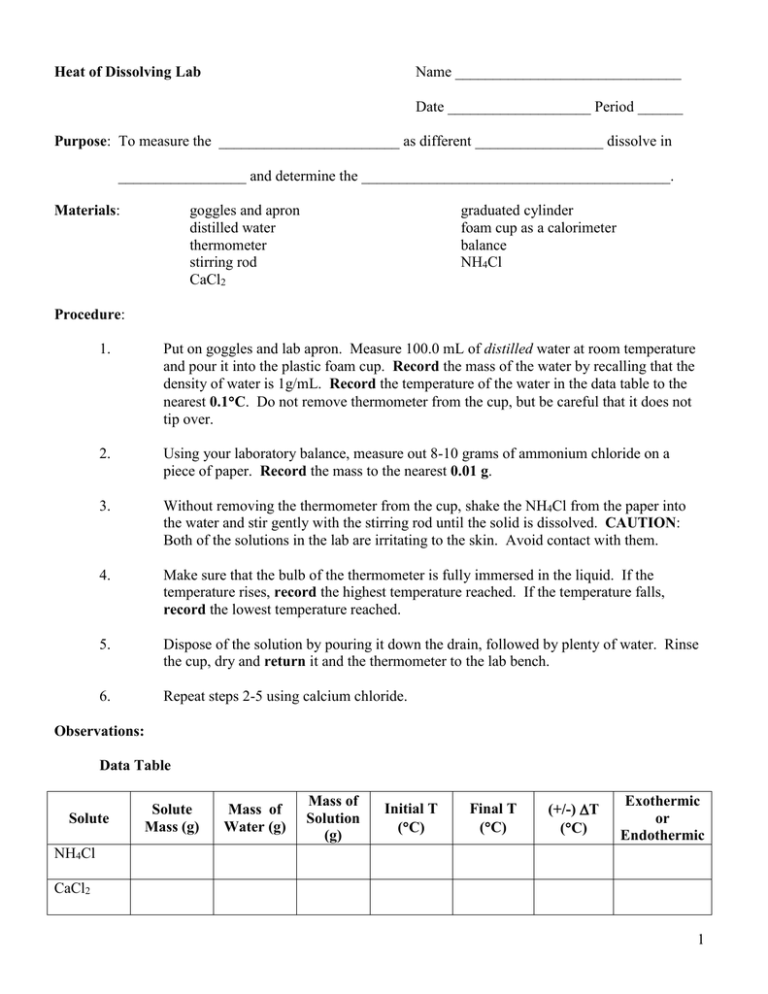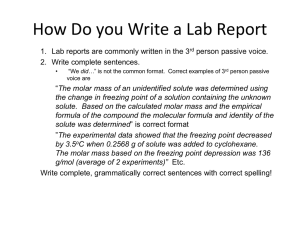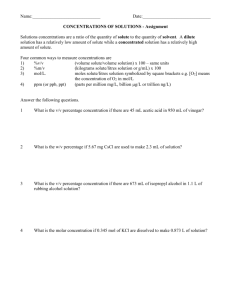Name ______________________________ Date ___________________ Period ______ _________________ and determine the _________________________________________.
advertisement

Heat of Dissolving Lab Name ______________________________ Date ___________________ Period ______ Purpose: To measure the ________________________ as different _________________ dissolve in _________________ and determine the _________________________________________. Materials: goggles and apron distilled water thermometer stirring rod CaCl2 graduated cylinder foam cup as a calorimeter balance NH4Cl Procedure: 1. Put on goggles and lab apron. Measure 100.0 mL of distilled water at room temperature and pour it into the plastic foam cup. Record the mass of the water by recalling that the density of water is 1g/mL. Record the temperature of the water in the data table to the nearest 0.1C. Do not remove thermometer from the cup, but be careful that it does not tip over. 2. Using your laboratory balance, measure out 8-10 grams of ammonium chloride on a piece of paper. Record the mass to the nearest 0.01 g. 3. Without removing the thermometer from the cup, shake the NH4Cl from the paper into the water and stir gently with the stirring rod until the solid is dissolved. CAUTION: Both of the solutions in the lab are irritating to the skin. Avoid contact with them. 4. Make sure that the bulb of the thermometer is fully immersed in the liquid. If the temperature rises, record the highest temperature reached. If the temperature falls, record the lowest temperature reached. 5. Dispose of the solution by pouring it down the drain, followed by plenty of water. Rinse the cup, dry and return it and the thermometer to the lab bench. 6. Repeat steps 2-5 using calcium chloride. Observations: Data Table Solute Solute Mass (g) Mass of Water (g) Mass of Solution (g) Initial T (C) Final T (C) (+/-) T (C) Exothermic or Endothermic NH4Cl CaCl2 1 Calculations for _________________________ 1. Calculate the change in temperature. T = Tf ─ Ti 2. Calculate the heat absorbed or released by the solution. The specific heat of water is 4.184J/gC. qsur = (mass of the solution) x (T of the water) x (specific heat of the water) 3. How much heat was released/absorbed (circle one) from/into the reaction? (qrxn = -qsur) qrxn = 4. Using the periodic table, calculate the molar mass of the solute. 5. How many moles of the solute were used in the reaction? 6. Calculate the molar heat of solution (H) in (+/-) kJ for the solute from the formula: Heat of the reaction q = rxn ∆H = Molar heat of solution = moles solute dissolved mole 7. Calculate the percent error of your experimental value. % error = accepted value - experimental value x 100% = accepted value The accepted value for H for NH4Cl is +14.8 kJ/mol. The accepted value for H for CaCl2 is –81.3 kJ/mol. 2 Calculations for _________________________ 1. Calculate the change in temperature. T = Tf ─ Ti 2. Calculate the heat absorbed or released by the solution. The specific heat of water is 4.184J/gC. qsur = (mass of the solution) x (T of the water) x (specific heat of the water) 3. How much heat was released/absorbed (circle one) from/into the reaction? (qrxn = -qsur) qrxn = 4. Using the periodic table, calculate the molar mass of the solute. 5. How many moles of the solute were used in the reaction? 6. Calculate the molar heat of solution (H) in (+/-) kJ for the solute from the formula: Heat of the reaction q = rxn ∆H = Molar heat of solution = moles solute dissolved mole 7. Calculate the percent error of your experimental value. % error = accepted value - experimental value x 100% = accepted value The accepted value for H for NH4Cl is +14.8 kJ/mol. The accepted value for H for CaCl2 is –81.3 kJ/mol. 3 Critical Thinking: Analysis and Conclusions 1. When sodium chloride dissolves in water, the ions dissociate. The equation for this reaction is NaCl(s) Na+(aq) + Cl-(aq) Write similar ionic equations to show the dissociation in water of each of the solutes used in the investigation. _______________________________________________________________________________ _______________________________________________________________________________ 2. Which reaction was exothermic? Which was endothermic? _______________________________________________________________________________ 3. Rewrite each of the ionic equations from Question 1 showing the molar heat of solution as a reactant or a product. _______________________________________________________________________________ _______________________________________________________________________________ 4. When the reactants get colder in an endothermic reaction, what has happened to the heat energy? _____________________________________________________________________________ 5. Is the change in enthalpy positive or negative for an exothermic reaction? Explain. __________ _____________________________________________________________________________ 6. Suggest two uses for these solution reactions in sports injuries or camping. _______________________________________________________________________________ 7. Which solids from this investigation could be used in each of your answers in the previous question? Explain your reasoning. _______________________________________________________________________________ _______________________________________________________________________________ 8. Why is a plastic foam cup used instead of a beaker in this experiment? For what piece of equipment is this cup a substitute? ______________________________________________________________________________ ______________________________________________________________________________ 9. How could you reduce experimental errors in this investigation? Explain your reasoning. _______________________________________________________________________________ _______________________________________________________________________________ 4






